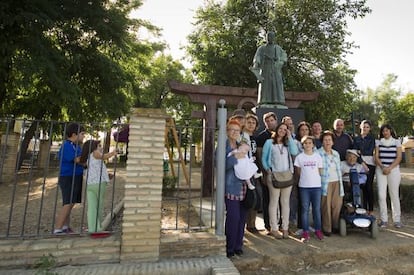A Samurai’s 600-strong Seville legacy
Many members of a 17th-century Japanese mission to the city may have stayed put


The story of the Keichô Embassy is an exotic one — as exotic as a Samurai warrior showing up in 17th-century Seville, or a Spanish missionary turning up in the Japanese city of Sendai around the same time. These two individuals, Hasekura Tsunenaga and Luis Sotelo, joined forces in a round-trip journey that took place exactly four centuries ago. Japan’s crown prince, Naruhito, is in Spain this week to commemorate the event, and will visit Coria del Río, where there are still remnants of an adventure that began in October 1613. Around 600 residents there share the same surname, Japón (Japan), and some historians believe they are the descendants of that early group of Asian adventurers.
“That trip was the first diplomatic expedition from Japan to Spain,” explains Fernando García Gutiérrez, a Jesuit who taught Art History at Sophia University in Tokyo for 15 years.
The feudal lord of Sendai, in northern Japan, instructed his “loyal Samurai” Hasekura to sail across the globe, says Oviedo University professor Yayoi Kawamura. This lord, Date Masamune, wanted Spanish monarch Felipe III to open the doors of his overseas empire so that Japan might engage in trade with Mexico. But there were more than economic interests behind the diplomatic embassy.
One of those other interests concerned the Franciscan friar Luis Sotelo. Japan was a desirable trophy for the missionaries, and the Jesuits, who had arrived in that country in the mid-16th century, had a head start in the southern portion of the archipelago. Sotelo wanted to create a new diocese in the north, where he would be bishop. For that, however, he needed support from the pope. That is why he joined an expedition that included a stop in Rome.
“Jesuits and Franciscans were adversaries in their missionary work,” notes Kawamura, who has researched the artistic vestiges left by that expedition. Kawamura is also the curator of the exhibition Lacas Namban. Huellas de Japón en España, at the National Museum of Decorative Arts in Madrid, which Prince Naruhito was due to inaugurate on Tuesday.
Hasekura and Sotelo came into port in Sanlúcar (Cádiz) in October 1614 after traveling for a year along the Spanish route, which included a stop in the Americas.
“Hasekura was the first Japanese person to cross the Pacific,” says Kawamura. Until then, the few Japanese who had reached Europe had taken the Portuguese route across the Atlantic and Indian Oceans.
The expedition then sailed up the Guadalquivir to one of the most important ports, Seville. City authorities were on hand to receive them with honors.
“It must have been amazing to watch them arrive,” says Manuel Ravina, director of the Indies Archive in Seville. He and his team followed the expedition’s paper trail and organized an exhibition that Prince Naruhito is also scheduled to inaugurate, De Japón a Roma en busca del sol de la cristiandad (or, From Japan to Rome in search of the sun of Christianity.) The part about the “sun of Christianity,” says Ravina, is taken out of Fray Luis Sotelo’s letters describing the trip.
The expedition members brought letters for Seville authorities written in Japanese by the lord of Sendai detailing his Western ambitions.
“We have learned that in this Republic many ships from all over the world gather, and for this reason there are many persons in it who are well-versed in the art of navigation. Have them all brought together, and find out through them whether it is possible to sail straight from Japan to this city, through which ways and ports it is possible to arrive; send us details about everything, so that, if this be feasible, our ships may sail that route every year,” reads part of the letter.
The audience with Philip III took place in January 1615. “The delegation was part of a recovery program,” says Satoru Satoh, the current Japanese ambassador to Spain. Sendai needed to recover from the earthquake that ravaged the area in 1611. Being part of the Spanish trade route was a key to that.
Following the audience with the monarch, the expedition members sailed to Italy to fulfill their religious goal. In November 1615, Paul V received them but failed to provide a definitive answer to their demands. Hasekura and Sotelo returned to Seville, but in the meantime, some political changes were being made.
“Just when they were in the middle of their embassy work, the Japanese government decreed a ban on Christianity,” explains Elena Barlés, a professor at Zaragoza University. A few Catholics were even executed. News traveled fast even then, cutting short the ambitions for the Keichô Embassy.
Having failed to meet his goals, Hasekura decided to return to Japan with his men in 1617. But the historian Víctor Valencia Japón, a native of Coria del Río, has found a divergence in the number of Japanese who arrived in Spain and those who went home three years later.
“The numbers don’t add up, which makes us presume that some of them either died or stayed behind,” writes Valencia Japón in an article about the expedition’s connection with Coria del Río.
“One of the members of this embassy was still in Spain in 1622,” he adds. It is precisely in the early 17th century when the first references to the surname Japón start turning up in Coria’s records. The oldest known mention is in a will dating from 1642. It is assumed that the descendants of the expedition members were given this surname.
The lingering questions over the origin of this name might be cleared up if a project by Toshimichi Yamamoto, of Nagoya University, finally comes to fruition. This researcher wants to compare the DNA of Coria residents named Japón with the genetic signature of Sendai residents. On Friday, Naruhito is scheduled to travel to Coria to meet several of these japones, as the alleged descendants are known.
So whatever happened to Hasekura and Sotelo? The Samurai warrior arrived in Japan in 1620 and died two years later. Sotelo decided to go to Japan as well, disguised as a trader. By then, the ban on Catholicism was already in force, but he took a chance. The Franciscan friar was burned alive in 1624 (two centuries later he was granted sainthood). Meanwhile, Japan embraced isolationism, and from 1640 onwards foreigners were forbidden from entering the country. Japan would not open up to the outside world again until the 19th century.
Tu suscripción se está usando en otro dispositivo
¿Quieres añadir otro usuario a tu suscripción?
Si continúas leyendo en este dispositivo, no se podrá leer en el otro.
FlechaTu suscripción se está usando en otro dispositivo y solo puedes acceder a EL PAÍS desde un dispositivo a la vez.
Si quieres compartir tu cuenta, cambia tu suscripción a la modalidad Premium, así podrás añadir otro usuario. Cada uno accederá con su propia cuenta de email, lo que os permitirá personalizar vuestra experiencia en EL PAÍS.
¿Tienes una suscripción de empresa? Accede aquí para contratar más cuentas.
En el caso de no saber quién está usando tu cuenta, te recomendamos cambiar tu contraseña aquí.
Si decides continuar compartiendo tu cuenta, este mensaje se mostrará en tu dispositivo y en el de la otra persona que está usando tu cuenta de forma indefinida, afectando a tu experiencia de lectura. Puedes consultar aquí los términos y condiciones de la suscripción digital.
Últimas noticias
Maduro pleads not guilty before the federal court in New York: ‘I am still the president of Venezuela’
A new test can detect Alzheimer’s from a finger prick
UN team enters Sudanese city of El Fasher after paramilitary massacre: ‘It’s like a ghost town’
A recipe for resistance: Indigenous peoples politicize their struggles from the kitchen
Most viewed
- Gilles Lipovetsky: ‘If you want to live better and fall in love, take Prozac, don’t look to philosophy’
- Alain Aspect, Nobel laureate in physics: ‘Einstein was so smart that he would have had to recognize quantum entanglement’
- Maduro’s downfall puts China’s relationship with Venezuela to the test
- Why oil has been at the center of Venezuela-US conflicts for decades
- Alvin Hellerstein, a 92-year-old judge appointed by Bill Clinton, to preside over Maduro’s trial in New York








































